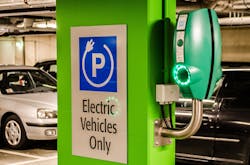The U.S. Aims to Expand EV Charging
Bipartisan legislation recently introduced in the House would form an Energy Secretary-led, $10 million grant program to support local governments, electric utility companies, universities, and others in pinpointing the most sensible locations for future electric vehicle charging stations.
Electric vehicles, or EVs, are emerging as an increasingly trusted, eco-friendly driving alternative to gas-powered cars—but their widespread adoption is limited by users’ accessibility to battery-charging stations, which exist mostly along major highways or in urban areas. According to NextGov, the Electric Vehicle Mobility Area Planning, or EV MAP Act, intends to help change that by prompting new data insights and analyses on current and coming EV use.
Reps. Tom O’Halleran, D-Ariz., and Michael Burgess, R-Texas, co-sponsored the bill. It was referred to the House Committee on Energy and Commerce the day it was put forward.
“The EV MAP Act addresses one of the most pressing issues EV owners have—range anxiety,” Burgess said in a statement, referring to drivers’ fear that their vehicles will run out of power before reaching charging points or their ultimate destinations. It’s considered one crucial barrier to the ubiquitous use of next-gen vehicles.
If passed, the bill would provide individual eligible entities with financial backing to help inform and steer future investments for EV charging stations, and determine where the power-portals will be most essential to meet present and forthcoming needs of the driver base.
Those selected would assess locations of EV owners in their specific areas right now, and during the half-decade following receipt of the grant, and produce a map “identifying concentrations of electric vehicle charging stations to meet the needs of current and future of electric vehicle drivers” in the area.
Source: NextGov
